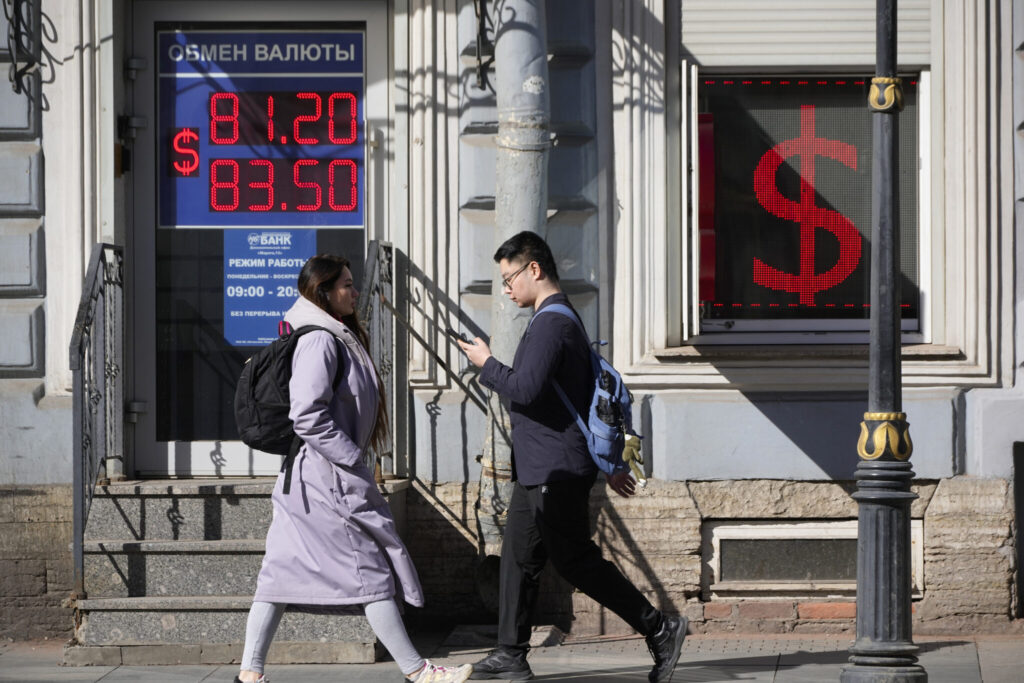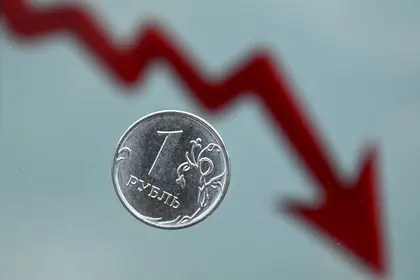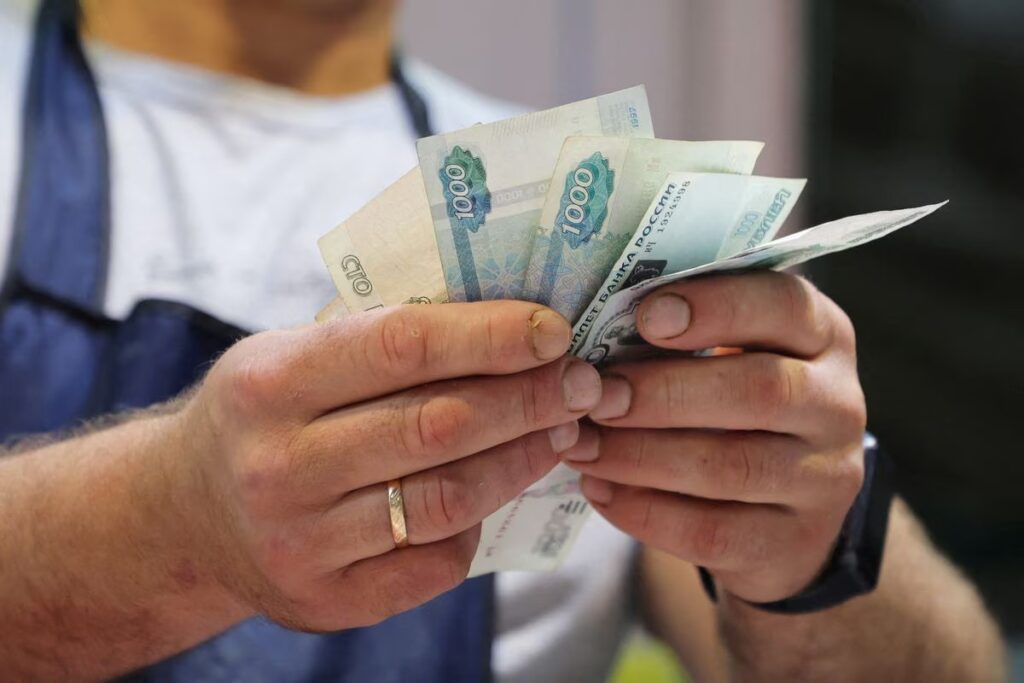Strikes on Moscow, public jitters and decreasing liquidity leave economists with concerns that the Ruble may eventually enter into “free fall.” The Russian Ruble (RUB) has continued to slide as it traded at a 17-month record low of 94.42 against the US Dollar on Friday. From its highest value in the past calendar year, 57.25 to the USD, the Ruble has lost 64 percent of its value – nearly 40 percent of that since this past January. The Associated Press has the story:
The Russian Ruble tumbles, hits lowest value against USD
Newslooks- (AP)
The Russian ruble dropped against the United States dollar in trading Friday in Moscow to its lowest level since the first month of the war in Ukraine.
The decline to 95 rubles against the dollar continued the Russian currency’s consistent fall since the beginning of the year, when it traded at around 65 — a drop of about 30%.
Friday’s value was the lowest point since March 28, 2022, state news agency Tass reported.
The Russian ruble tumbled over 2% to a more than 17-month low past 94 against the dollar on Wednesday, pressured by political risk, falling oil prices and concerns the finance ministry may switch to foreign currency purchases this month.
By 1609 GMT, the ruble was 2% weaker against the dollar at 94.16 , earlier hitting 94.32, its weakest point since March 28, 2022.
It had lost 1.8% to trade at 103.00 versus the euro , also a more than 16-month low, and had shed 1.8% against the yuan to 13.07 .
Brent crude oil, a global benchmark for Russia’s main export, was down 2.2% at $83.03 a barrel, sliding back from its strongest since April 17 of $85.99.
A high-rise building in Moscow’s business district that houses three Russian government ministries was struck by a drone for the second time in three days on Tuesday, forcing companies to think about their employees’ safety.

The ruble was also hurt by market uncertainty over whether the finance ministry will this month continue with foreign currency sales to cover shortfalls in Russia’s energy export revenues, or switch to purchases.
“The rise in oil prices, coupled with the weakened ruble, reminds us of prospects for the start of yuan purchases under the budget rule,” said Bank St Petersburg analysts.
Russia resumed foreign currency interventions in January, selling China’s yuan rather than what it terms “unfriendly” Western currencies.
Russian stock indexes were mixed.
The dollar-denominated RTS index (.IRTS) was down 1.5% at 1,040.2 points. The ruble-based MOEX Russian index (.IMOEX), which in the previous session hit its strongest mark since before Russia’s February 2022 invasion of Ukraine, was 0.4% higher at 3,106.5 points.
The MOEX is abnormally high, said Sinara Investment Bank in a note. The index still remains well below the record highs above 4,000 points hit in late 2021, stung by geopolitics.
“Retail investors’ euphoria may continue today both on the back of dividend reinvestment and the weakening rouble. However long-term growth perspectives are in doubt due to growing risks,” Sinara said.
After Russia sent troops into Ukraine in late February 2022, the ruble plunged to as low as about 120 against the dollar, but recovered quickly as the Russian Central Bank undertook support measures.

This photograph taken on July 6, 2022 shows a Russian ruble coin in Moscow.
What’s caused the latest jitters?
It was likely due to two things.
Firstly, Ukraine’s second night of successfully launching drone strikes on a high-end financial district of Moscow, prompting Russian society to see that there are increasing risks to Russia’s economy.
Secondly, mounting uncertainty as to how the Russian Ministry of Finance would – or could – maintain an exchange rate closer to 90 against the Dollar.
What does this mean for the average Russian?
Consumers in Russia – who have complained in recent months for having seen the real purchasing power of their Rubles decline as it buys just shy of half what it did earlier this year – have no reason to be optimistic.
Economic experts predict soaring prices for goods and services, a coming hyperinflation with prices increasing and wages not being adjusting. Recall that a very large part of the consumer basket in Russia is based on imported goods, so prices will go up very fast.
What’s hyperinflation?
Hyperinflation is caused by a surplus supply of a currency which triggers a loss of value sometimes exceeding 50 percent per month.
Russian investors, concerned by reports of Russia’s failure to sure-up support in the Middle East or with China, may begin to sell their Rubles, which would only exacerbate the problem of surplus Rubles with few markets willing to buy them.
Given the limited market for Rubles, Experts say that the Ruble predominantly serves some purpose in international trade, but in general, the exchange rate is very artificial. Not being able to maintain even that is a sign of extreme problems and weakness.
What’s the bigger economic picture in Russia right now?
Despite some economists arguing that the data released by the Russian Central Bank may be fudged, others have expressed surprise that in light of the largest packages of sanctions in history being set against Russia, the Russian economy has not only seemingly maintained itself, but may actually be growing.
This past May report shows that Russia had reached its lowest unemployment rate, 3.3 percent, since the collapse of the Soviet Union in 1991.
A Business Insider piece this week, verbosely entitled “The Kremlin has pumped so much money into the economy that it’s creating a boom – but this house of cards could topple anytime soon,” cautioned that “Putin is boosting the production of military equipment and raising pensions, salaries, and other benefits for people who are not well-off. The state is also subsidizing mortgages.”
So, things might not be too bad despite the Ruble jitters?
Not so fast – a confluence of geopolitical matters unfavorable to Russia and its war in Ukraine, assures that the Ruble will keep falling.
The question is how fast. If traders start believing the RMoF stops supporting it, it will fall very fast, very fast. The exchange rate and Ruble might be then in free fall.
One of the first signs of a coming ruin of the Ruble would be increases in prices for durable goods but would be more evident and felt by average citizens when non-durable goods, such as household goods and food start to become more expensive.
However, the big warning sign is that things are spiraling out of control when there are delays in making payroll for the government’s employees.







